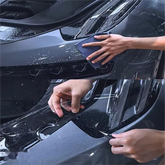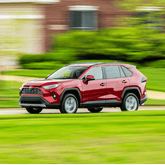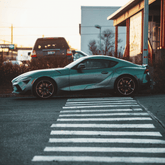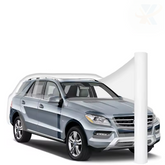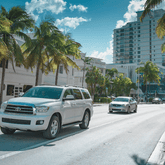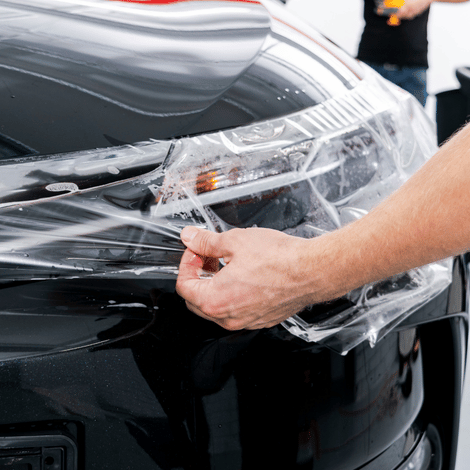Tesla PPF: The Ultimate Guide to Paint Protection Film for Your Tesla Model
Paint protection film is essential among Tesla car owners who want to keep their vehicles in perfect condition. This manual will look into different aspects of PPF, including its components, application techniques, and benefits specific to various Tesla models. It is important for individuals to know about these technical features and performance advantages because they help in understanding how this new invention protects the outside of the car from environmental threats such as road tar, UV rays, and chemical stains and improves its outlook. We shall also consider various factors when choosing good quality PPFs, such as the steps involved during installation and ways to maintain them so that your money does not go down the drain. If you have just bought yourself a Tesla or are planning on upgrading yours, then be rest assured that after going through this guidebook, everything will be clear concerning paint protection films.
What is Tesla Paint Protection Film (PPF)?

Understanding Tesla PPF
The Tesla Paint Protection Film (PPF) is a clear polyurethane material created to defend a vehicle's paintwork against scratches, chips, and other forms of damage. PPF has been designed to self-heal after minor abrasions caused by heat exposure thus ensuring that its surface remains clear and glossy with time. Moreover, this film acts as a shield from harmful UV rays, which may lead to fading of paints, while also resisting environmental contaminants like bird droppings and tree sap. It is so flexible and perfectly fitting that it seamlessly wraps around all the unique shapes of any Tesla, thereby protecting them and improving their appearance. In essence, those who use Tesla-specific PPF solutions can protect their cars better than others because they can preserve their resale value, too, besides benefiting from advanced paint protection technology.
Benefits of Paint Protection Film
Paint Protection Film (PPF) is a good thing for car owners to have, especially Tesla owners or anyone else who has an expensive vehicle. First, it prevents scratches and chips in the paint caused by things like rocks and other debris you might find on the road. Secondly, it can repair itself when scratched lightly and heated up so as not to mar its transparency or shine. Thirdly, this film blocks out UV rays, which would fade your paintwork if left unprotected under sunlight for too long; moreover, it acts as a shield against chemical contaminations such as bird droppings or tree sap, which could ruin a car’s finish. Finally but not least importantly – resale value! Putting PPF on your Tesla will save you money because when you want to sell it later, there won’t be many marks on its shiny surface.
Types of Film Available
Multiple Paint Protection Films (PPF) are sold on the market for different car owners’ needs. The common ones are as follows:
- Self-Healing Films: They have heat-active features that allow them to heal from minor scratches and scuffs, thus keeping a smooth surface.
- Matte Finish Films: These films do not alter the look of vehicles with satin or matte paint finishes while still safeguarding them.
- Gloss Finish Films: These films can improve traditional glossy finishes and protect against damage caused by environmental elements.
- Pre-Cut Kits: Designed specifically for certain models, these kits fit perfectly without requiring manual cuts hence decreasing risks during installations where mistakes might lead to damages.
- Universal Films: They provide an affordable choice as they can work well on different areas of a vehicle, thereby suited to those who need essential protection economically.
It is vital to select the best PPF type depending on use and desired appearance because it ensures that both protection and aesthetic values are enhanced.
How Much Does Tesla Model Y PPF Cost?

Average Cost for Tesla Model Y
The price of Paint Protection Film (PPF) for a Tesla Model Y differs significantly. For example, the type of film used, the area covered, and the professional installer, among others. A full wrap typically costs between $2,500 – $5,000 on average. Partial coverage options only protect high-impact areas like fender hoods or front bumpers, and they range from $1k-$2k in most cases. Other considerations can impact the final price, such as the brand name chosen and complexity required during the installation process, along with regional labor rates that may apply to where you live, but no matter what, it’s always good because not only does it make your car look better but also protects against damage which could affect resale value at some point down the line if left unprotected so invest now!
Factors Affecting the Cost
Many factors can affect how much Paint Protection Film (PPF) a Tesla Model Y costs overall.
- Film Quality and Brand: Typically, premium films cost more than basic ones because they’re clearer, more durable, or can heal themselves better. Moreover, if a brand is well-known for being good quality or high-performance people will pay extra money just for that name recognition.
- Complexity of Installation: The amount of time spent on labour largely depends on the intricacy involved with installing it. This means that areas like curves and edges which require lots of skill and time will have higher installation fees attached to them.
- Coverage Area: Unsurprisingly, the chosen area to be covered directly affects price. If someone wants their entire car wrapped in this stuff then naturally it will cost more than if they only want certain parts protected with PPF.
- Regional Pricing Variations: Different regions charge different amounts based off where they are geographically located within an expensive city etc.. Some places might see an increase in both material & labor expenses due to higher living costs while others may vary pricing according to how much competition there is locally, along with levels of demand from customers residing nearby.
- Additional Services: Adding other services like paint correction or ceramic coating can also raise the total project cost through these measures offer greater protection, too
Knowing these things should help anyone looking into getting PPF to understand what they’re paying for as well as how best to maintain their investment in such products towards keeping cars looking fresh and new.
Cost Breakdown of Full Front, Rocker Panels, and More
When installing Paint Protection Film (PPF) on specific parts such as the full front and rocker panels, one should understand the average cost of each section.
- Full Front Coverage: Full front coverage can include the front bumper, fenders, headlights and hood. Generally, the cost ranges from $800 to $2,500 depending on the quality of the film and the complexity of the installation. More expensive films are priced at the upper end because they offer better protection.
- Rocker Panel Coverage: Protecting rocker panels often costs between two hundred dollars ($200) and six hundred dollars ($600), though prices may vary according to what type of film is used or how much area it covers.
- Additional Areas: Door edges are commonly done along with rear bumper and side mirrors; this could add an extra hundred dollars ($100) up to five hundred dollars ($500+) depending upon where they’re being applied relative to other parts being wrapped as well as which brand/type/quality level gets selected for use during installation process specifically tailored towards those particular locations mentioned above.
In conclusion, pricing out PPF can be wildly different based on what options are chosen by whom installs them, also taking into consideration which brands might have been selected throughout those spots—all in all, resulting in a complete investment decision for Tesla Model Y owners who want ultimate protection for their vehicle.
DIY PPF Installation: Is It Worth It?

Pros and Cons of DIY Tesla PPF Installation
Pros
- Savings: Deciding to install PPF on your own can save you a lot of money in terms of labor. Hiring professionals to do it for you is quite expensive, and this approach allows car owners to distribute their budgets better.
- Flexibility and Control: Doing it yourself lets people work at their own speed without being restricted by time. They are also free to choose which parts to concentrate on based on their discretion or preference.
- Personal Fulfillment: Finishing a do-it-yourself task successfully can be fulfilling because it gives one a feeling of pride as well as empowerment over taking care of vehicles.
Cons
- Required Skill Level: A certain amount of expertise is necessary when attempting self-installation with paint protection film. If done incorrectly, bubbles may appear under the surface; the lining up could go wrong or even start peeling off too soon thereby reducing its safeguarding effect.
- Time Commitment: Although allowing room for variation in scheduling, DIY’ing may eat into much time; one’s estimation might be way off mark especially if he/she hasn’t previously tried achieving an acceptable result within such durations.
- Warranty Limitations: Majority professional grade films come with warranties that become null and void unless installed by an accredited expert thus leaving motorists vulnerable after application in case anything happens.
- Ultimately, there are many benefits associated with installing PPF on your Tesla using DIY methods; however, potential drawbacks should not be overlooked so as to ensure maximum protection and satisfaction with results gained from this undertaking.
Step-by-Step Guide for DIY PPF
- Get Tools: Make sure you have all the necessary equipment such as PPF, a heat gun, squeegee, knife and cleaning solution.
- Clean Surface: Thoroughly wash and dry the part of the vehicle where PPF would be applied to get rid of dirt, wax or any other debris.
- Prepare The Film: Cut the size of PPF leaving extra material around its edges for proper fit and handling.
- Put On The Film: Start from one edge, carefully putting down the film on the surface using a squeegee so that no air bubbles are left behind, and it sticks everywhere evenly.
- Use Heat: Use heat gun at an appropriate distance which will soften the film making it easier to mold into shape of different contours found on vehicles.
- Trim Excess Film: After completing installation take sharp knife and cut off any additional films for clean finish.
- Check Again: When you think you have finished go over once more checking if there are still some imperfections or bubbles adjusting them while keeping warm from heating device.
- Cure The Film: Let PPF cure for suggested time not coming in contact with moisture or extreme temperatures in order to achieve best adhesion.
Common Mistakes to Avoid
- Insufficient Surface Preparation: If a vehicle is not cleaned well, it may result in poor adhesion and low visibility of contaminants under the film.
- Incorrect Film Sizing: Cutting the PPF too small might leave some areas exposed; on the other hand, using too much material can make trim work messy and difficult.
- Neglecting Heat Application: Failure to properly use a heat gun can cause bubbles as well as ill-fitting because there will be no conforming of films to the shape of the vehicle.
- Ignoring Air Bubbles: When air bubbles are left unattended during installation, they can affect how the film looks and performs.
- Premature Exposure: Before curing, should not be subjected to moisture or extreme temperatures since this may lead to weak adhesion followed by peeling off.
Professional PPF Installation for Tesla

Choosing the Right Installer
When it comes to picking a professional installer for Paint Protection Film (PPF) on your Tesla, there are some things you should think about.
- Experience: When installing PPF, you need someone who knows their way around the curves and unique features of Teslas. So make sure that they have experience doing this before!
- Certifications: It’s always good if an installer has been trained by reputable manufacturers because then we know how much skill these people have got under their belts.
- Portfolio: To see if they do quality work or not just take a look at what projects they’ve completed in the past – were they precise? How good was it really?
- Reviews and Testimonials: Testimonials and reviews say a lot about any business. So check them out! You never know what kind of information could be hiding in there that might help you make up your mind one way or another.
- Warranty: Protecting your investment is important. Ask the installer about their warranties because sometimes things happen outside our control – both with films themselves as well as during installation process.
Installation Process Explained
To be precise and effective, the installation of paint protection film (PPF) has to go through some vital stages, which include:
- Preparation of the Surface: This step involves cleaning the car's surface by washing off all dirt, grease, or other contaminants that may interfere with its adhesion.
- Alignment and Cutting: The PPF is measured and cut accurately so as to fit different parts of the vehicle tightly without leaving unnecessary material hanging while still having allowance for going around curves and edges.
- Film Application: In this stage, a solution is used to position the film onto the surface whereafter heat may be applied in order for it to take up shape along contours better.
- Pressurization & Squeegeeing: During this process, gentle pressure is applied on top of squeegee strokes made across films’ surfaces thereby removing air bubbles as well excess solutions leaving behind smooth finishes free from any blemishes or imperfections.
- Drying Time: It is important that after installation, enough time should be given for drying before anything else can come into contact with these newly installed films. Such an action helps ensure their full attachment since they become more stable when allowed some hours rest without being disturbed; also preventing exposure from moisture or extreme temperatures which might cause peeling off.
Quality Check After Installation
To know whether the Paint Protection Film (PPF) is in good condition and appearance, it is important to conduct a post-installation quality check. The following are areas that need to be looked into:
- Check for Adhesion: Examine the film edges to affirm its attachment to the vehicle surface without any raise or peeling off.
- Uniformity of Surface: This involves verifying if there are any observable defects like bubbles, creases or dust particles trapped under the film and dealing with them immediately.
- Alignment Confirmation: Ensure that PPF aligns properly with contours of a car and it does not hinder movement around joints or other flexible parts.
- Scratch Test: Visually inspect for scratches which might have occurred during installation thereby keeping this material clean.
- Cleaning After Installing: In conclusion, clean this component by using mild detergent solution in order to get rid of residues or finger prints hence improving general outlook after putting it on.
Protecting Your Tesla with PPF: What to Expect

How PPF Protects Against Stone Chips and Small Debris
Paint Protection Film (PPF) is uniquely formulated to guard vehicle surfaces against different types of damage, such as stone chips and small debris. The material used in making this film is urethane which is tough and flexible. Impact resistance is one of the main features that make it suitable for this purpose since it absorbs energy from flying stones or gravel effectively. In such cases, when any object hits the applied film, PPF remains undamaged, thereby preventing any harm to the paintwork underneath. Additionally, most recent PPFs have self-healing characteristics where light scratches and scuffs can be made to disappear by heat exposure over time, thus providing even more protection for the appearance of vehicles. This high level of safety is achieved through the clarity and near invisibility of Paint Protection Films.
Wear and Tear: Longevity of Paint Protection Film
Several factors determine the lifespan of paint protection film (PPF) such as quality of the film, techniques used during installation, and environmental conditions. Usually, good PPF products last between 5 and 10 years depending on exposure to UV rays, weather elements like rain or snow, and how it is taken care of. To make sure that it serves for long, one should regularly clean as well as maintain them because if left dirty with things like road dirt or bird droppings, they can affect visibility through these films, which will eventually lead to their ineffectiveness too. Also, technology has led to the creation of stronger films that do not turn yellow easily, and neither do they get scratched, hence becoming more durable than before. Over time, they are still doing their job best- protecting vehicle surfaces from any harm but still looking nice.
Maintenance Tips for PPF
For you to make sure that paint protection film (PPF) remains effective and lasts long, here are some tips to maintain it:
- Regular Cleaning: Regularly clean PPF using a pH balanced car wash solution and soft cloth or sponge. This will help remove dust particles which can lower its performance.
- Avoid strong chemicals: Do not use hard cleaners, solvents, or waxes on the PPF because these may damage it. Instead, use products designed for PPF care.
- Soft Drying: When drying after rinsing, softly pat dry with another clean microfiber towel rather than rubbing against it which could scratch through this material.
- Shield from severe conditions: Whenever possible try parking under shade or in garages thereby reducing exposure time of UV rays on vehicles as well as minimizing damages caused by environmental factors like bird droppings etc.
- Check frequently: It is advisable to visually inspect the entire surface area of your film regularly looking out for any wear signs especially along edges where peeling could be starting off. When noticed early enough such areas need immediate attention either through fixing them back onto car bodywork properly so that they continue performing their duty well or replacing altogether if necessary hence ensuring continued comprehensive protection throughout all times.
In order to achieve this, owners should follow these practices since they will ensure both the effectiveness and beauty of Paint Protection Film over a period.
Frequently Asked Questions by Tesla Owners

Which Areas of the Car Should Be Covered?
When applying paint protection film (PPF) on a car, it is important to prioritize the most vulnerable parts. These may include:
- Hood and Fenders – these parts are more exposed to road debris and bugs that cause scratches.
- Front Bumper – this area should be protected because of its exposure to air-borne particles as well as minor possible collisions.
- Side Mirrors – scratch-prone regions that need to stay clear should be covered, too.
- Door Edges – chips and scratches from frequent use can easily be prevented by shielding door edges which greatly minimizes wear and tear.
- Rear Bumper – rear bumpers get scratched when loading or offloading cargo so additional shielding is necessary here too.
By covering all these places with PPF, you will not only improve the general lifespan of your vehicle but also make it look better while protecting it against common dangers.
Is PPF Visible on My Tesla Model?
PPF (Paint Protection Film) is created to be almost undetectable so that it doesn’t ruin the original look of your Tesla model. Good quality PPF, if installed correctly, fits perfectly with the curves of your vehicle and allows the paint color and finish to appear without any alteration. In some cases, there might be a little texture or gloss variation under certain lights, but usually, this is very subtle and doesn’t take away from how great the car looks. All in all, many Tesla owners discover that PPF not only makes their cars look better but also provides good defense against scratches and other environmental damages.
Can PPF Be Removed or Replaced?
Definitely, without ruining the paint underneath, Paint Protection Film (PPF) can be taken off or substituted. This usually includes heating up the adhesive with heat and then peeling off the film slowly. After some years, experts in installation advise replacing PPF since it becomes less protective as it wears out from environmental factors. While changing PPFs, you should clean the surface entirely before placing another one so that it sticks better and protects more effectively.
Reference Sources
Frequently Asked Questions (FAQs)

Q: What is a Paint Protection Film (PPF), and how does it benefit Tesla owners?
A: A transparent film called the Paint Protection Film (PPF) is put over the paint of vehicles so as to shield it away from damage such as stone chips, scratches, and other small debris. For those owning Teslas, mostly Model 3 or Model Y, this helps them keep their car bodies in good condition even under different driving conditions which may accelerate wear and tear.
Q: Why should Tesla Model Y owners consider a Model Y paint protection film?
A: If you own a Tesla Model Y, you can protect its paint from stone chips, scratches, sand, or other small debris damage by installing a Model Y paint protection film. The film acts as armor against environmental hazards that could ruin its aesthetic appeal for many years, thus saving on frequent repainting jobs.
Q: What areas of my Tesla are most vulnerable and should be protected with PPF?
A: The most vulnerable areas of your Tesla that should be protected with PPF include the front bumper, headlight, fender, a-pillars, mirror caps as well and full front end, including rocker panels. These parts are exposed to everyday driving conditions, which might lead to damages caused by coming into contact with various objects along the way.
Q: How does PPF for Tesla Model 3 differ from other models?
A: PPFs meant for Teslas differ depending on the type. For example, the PPF for the Tesla Model 3 has been designed to fit precisely onto contours and features found only in Model 3s, hence ensuring maximum protection coverage while also helping safeguard against scratches, stone chips, etcetera, during drives.
Q: What are the different paint protection film materials available for Teslas?
A. There are several kinds of paint protection material films one can use for their Teslas, such as 2x clear protective film, self-healing films, and advanced multi-layer transparent films. These different types offer varying degrees of durability or self-healing abilities, with premium alternatives affording better safeguards against damages inflicted on your vehicle’s paintwork.
Q: Can PPF be utilized on the Tesla's interior paintwork?
A: Yes, besides the exterior paintwork, there are other sections of a Tesla that can be covered with PPF. Commonly, additional places include A-pillars, headlights, and luggage areas. This ensures safety for your car and preserves its overall look and functionality.
Q: How does self-healing paint protection film work?
A: Self-healing paint protection film functions by employing advanced polymer attributes that allow the film to return to its original shape upon being subjected to heat. This means that small scratches or scuffs on the film will vanish over time, thus helping you maintain a smooth clear coat shield over your car’s paint job.
Q: Is professional installation necessary for Tesla’s protective film?
A: Though you could do it yourself, professional installation is highly recommended when it comes to fitting protective films onto Teslas. Fitting professionals have the special tools and know-how needed to achieve the perfect finish while maximizing the protection offered by such films; they also ensure that nothing goes wrong so far as appearance is concerned – your car should look flawless when done!
Q: What are some good brands of PPFs for Teslas?
A: There are several great options out there, but one brand we would recommend is Tesbros; this company produces high-quality kits with precision fitment, which many people regard as being among the best available… Other reputable companies within this sector provide strong yet flexible shields capable of lasting very long durations without showing signs of deterioration – these types tend to work quite effectively according to most owners who have had their paints protected using them!
